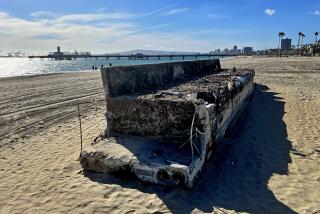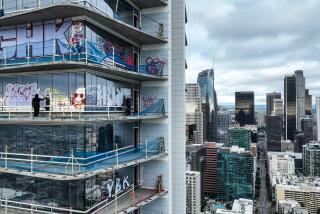Concrete Residue Drips Onto Vehicles at Airport FlyAway
- Share via
Some travelers who parked in the new garage at the Van Nuys FlyAway returned this week to find their vehicles splattered with concrete residue that had spilled out of the ceiling during recent heavy rains.
The leaching concrete dripped onto dozens of vehicles and prompted the Los Angeles airport agency to briefly shut down the garage after receiving complaints from irate owners.
The leaks are the latest in a series of problems to plague the park-and-ride expansion project.
The airport agency attributed the whitish fluid that spotted vehicles to “some minor nonstructural cracks.” Airport officials said they had asked the builder, Sylmar-based Tutor-Saliba Corp., to make necessary repairs.
The company’s president, Ronald N. Tutor, said Friday that he wasn’t aware of the problem but added that such leakage isn’t unusual in garages because of the porous nature of concrete.
“I defy you to go out into any parking structure you can find and not find a series of nonstructural cracks,” he said. Tutor called the problem “trivial” and said his company will investigate whether it should reimburse vehicle owners.
The cracks in the garage, which was fully opened for travelers in February, are the latest development in an ongoing dispute between the airport agency and Tutor about the severity of several alleged construction defects.
The disagreement has taken on added urgency recently because Tutor-Saliba submitted the lowest bid -- at $241.7 million -- to rebuild the southernmost runway at Los Angeles International Airport. The Airport Commission is scheduled to award a contract for the runway Dec. 5. Because it will use federal grants to help pay for the runway, the commission is required to accept the lowest bid.
Last year, airport officials threatened to remove Tutor-Saliba from the $34-million FlyAway project, next to Van Nuys Airport, saying the firm had not fixed a series of construction flaws in the garage. City building inspectors found that concrete columns were not properly aligned and that the concrete used in several columns, some flooring and a ramp was substandard, among other issues.
Tutor-Saliba later demolished and removed several concrete columns, reinforced some concrete beams and replaced substandard concrete. The company’s president has called the defects “minor” and said none of them threatened the garage’s structural integrity.
The airport agency hopes that the expanded park-and-ride, which includes a new bus terminal, will increase the FlyAway’s popularity. About 750,000 people parked at the 30-year-old facility last year and boarded buses for LAX.
On Friday, the five-level parking garage reopened after about 20 hours, as maintenance workers blocked off spaces where cracks in the ceiling need to be patched. About one-fifth of the structure’s 2,063 spaces appeared to be affected.
In the meantime, many filthy cars and trucks remained in the garage, awaiting the return of their unsuspecting owners.
A bronze Silverado pickup had white, filmy residue splashed over its cab.
A few rows over, a black Honda was blotched with hardened liquid on the passenger-side window and door.
A white BMW had splotches caked on its hood. And a white Toyota Corolla had similar blemishes on its front end.
Airport officials declined to discuss the matter, but released a statement saying that “in most cases, the residue can be washed off without damage to the vehicle’s paint.”
But a structural engineer said the problem might not be so easy to fix for vehicles that remain unwashed for days.
“Cement is acidic. When it leaches through, it tends to corrode -- especially metallic substances,” said Professor Hank Koffman, director of the Construction, Engineering and Management Program at USC. “If it’s been sitting there eating up the paint, they would have to sandblast it and get a new paint job.”
More to Read
Inside the business of entertainment
The Wide Shot brings you news, analysis and insights on everything from streaming wars to production — and what it all means for the future.
You may occasionally receive promotional content from the Los Angeles Times.









